The Clevo P870DM2 / Mythlogic Phobos 8716 Laptop Review: DTR With GTX 1080
by Brett Howse on October 27, 2016 2:00 PM ESTDisplay
Not too many years ago, gaming laptops were still shipping with TN displays on the large screen laptops. Luckily that’s no longer the case, and the Clevo P870DM2 / Mythlogic Phobos 8716 is available with two choices in display. The base model is a 1920x1080 IPS panel with a 120 Hz refresh rate. That’s great to see in a gaming laptop, and looking at the gaming results in the last section, this laptop can easily hit 120+ frames per second to keep up with that refresh rate. Mythlogic also offers a a 3840x2160 (UHD) AHVA panel with the more common 60 Hz refresh rate, but also includes G-SYNC. For those that want to meet somewhere in the middle, there is now a 2560x1440 AHVA 120 Hz panel option as well with G-SYNC.
The review unit has the lowest resolution panel, which is going to be the highest frame rate at the native resolution. The GTX 1080 in this review unit could likley handle at least the 2560x1440 though, and even the UHD would still give reasonable performance especially with G-SYNC.
To measure a display’s characteristics, we use an X-Rite i1Display Pro Colorimeter for brightness and contrast readings, and an X-Rite i1Pro2 Spectrophotometer for accuracy readings. SpectraCal CalMAN 5 Business with a custom workflow is the software used. Mythlogic shipped the device with an included ICC profile, but I found it actually was more accurate without the ICC profile, so the measurements below will be with it disabled.
Brightness and Contrast
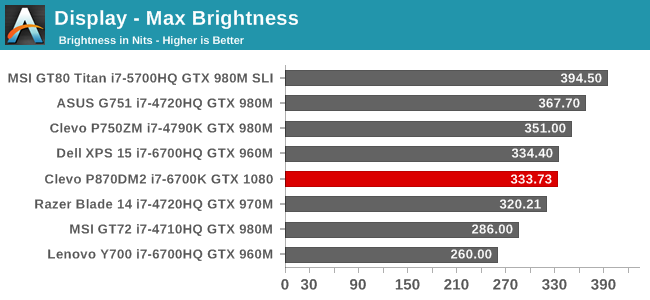
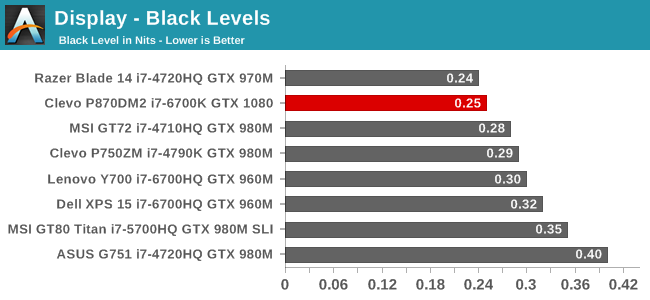
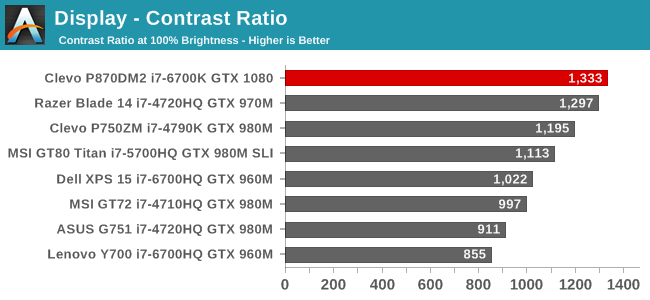
333 nits is a decent brightness for a laptop like this, which is unlikely to get used outdoors very much. What is more impressive though is the excellent black levels, which gives a great contrast ratio over 1300:1. For those that like to use their computer in the dark, the display goes down to 16 nits, which isn’t the lowest measured, but should be adequate.
Grayscale
SpectraCal CalMAN 5 - Grayscale with included ICC Profile
SpectraCal CalMAN 5 - Grayscale with no ICC
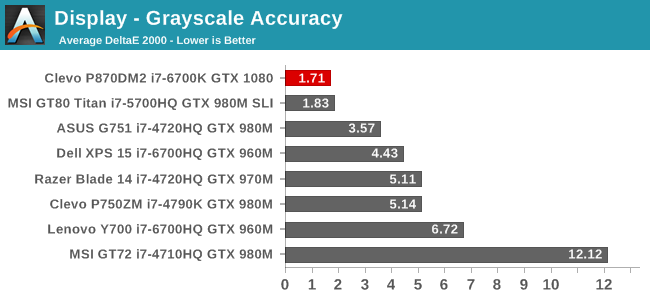
The top image is the laptop with the included ICC profile enabled. It’s pretty clear how much it doesn’t help, and makes the grayscale have much higher errors, and the gamma is way too high. With the ICC disabled, the grayscale is fantastic at an average dE2000 of just 1.7. Gamma still has some issues, but overall it’s much better. I don’t provide ICC profiles of laptops I’ve reviewed because there’s no guarantee an ICC made on panel A will help panel B, and in this case, it makes it much worse. The white point is very good too, which is clear when you see how closely the red, green, and blue track at the different white levels. This is one of the best grayscales on any laptop tested.
Saturation
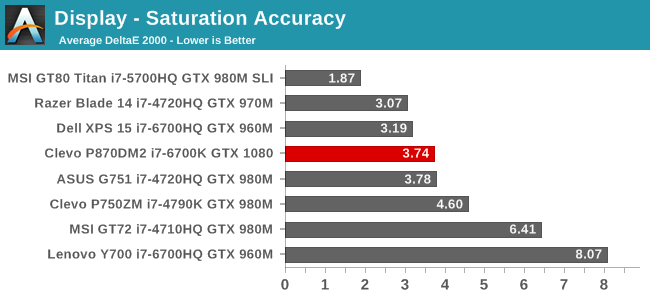
Unfortunately, the saturation results weren’t quite as good as the grayscale, but with an average dE2000 of 3.75, it is pretty good in a notebook of this caliber. There isn’t just a single color which is off pulling the scores up, with all of the colors having errors ever three at some point in the sweeps. Still, it’s a decent result for this type of laptop.
Gretag MacBeth

The GMB score is the worst of the bunch, but it’s still not too bad. 4.3 is definitely above the error levels under 3.0 that would be best, but the overall average is decent. The worst scores are the skin tones, and individual one color even has an error level over 8. Although better is always better, Mythlogic isn’t selling this notebook for color sensitive work, and if you are going to be doing that it would be best to get an external monitor. This is a pretty good result for a gaming notebook.
Overall, the 1920x1080 120 Hz display offers great out of the box white levels, with decent color accuracy. It could be better, but it’s far from the very blue displays seen a few years ago, and the higher refresh rate is going to be a benefit for gaming where movement can be very quick. The gaming I did on this notebook felt very smooth, which was also likely helped by the massive GPU available.


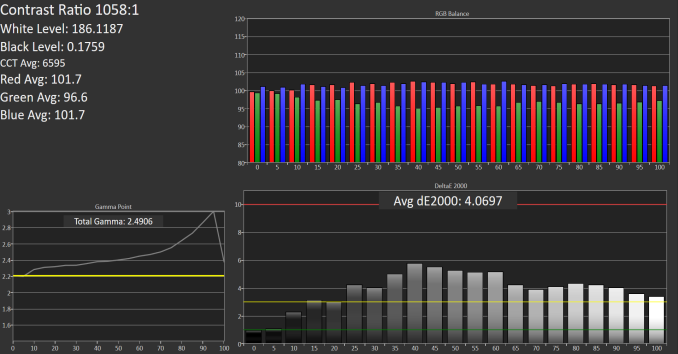
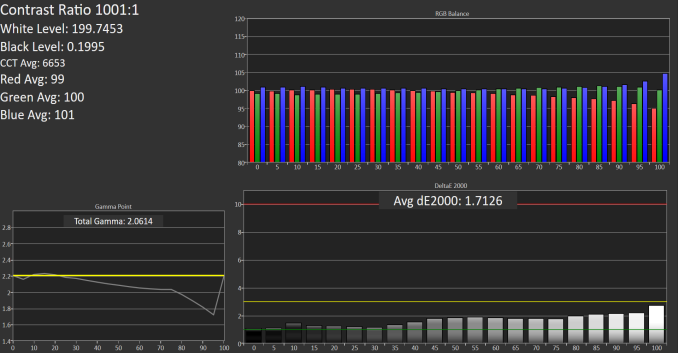










61 Comments
View All Comments
Morawka - Thursday, October 27, 2016 - link
i dont think nvidia is done with pascal mobile parts. I'm sure they will release some midrange stuff here soon.Meaker10 - Friday, October 28, 2016 - link
The vapor chamber cooler on the SLI 1080 config can keep both cards at 1910mhz core clocks during gaming with both cards loaded with the right mounting :)The_Assimilator - Friday, October 28, 2016 - link
Given that Pascal is probably the last gasp of the Maxwell architecture, I think it was a simple matter of nVIDIA wanting to push it as far as it could go. (That, and wanting to crush AMD Polaris.) So slightly higher TDP was probably not a concern of theirs, especially given how much more performance you're getting for that power.As for your desire for potentially slower cards that draw even less power, I'm actually with you on that one. I'm tired of seeing "low-end" cards that require dual-slot cooling and additional power connectors. Bloody hell, back in the day, the 8800 GT was near the top of the hill in terms of performance and it was a single-slotter with 1 PCIe power connector.
BillyONeal - Thursday, October 27, 2016 - link
I'm happy they stopped with the mobile GPU mess. I was sick of looking at laptops and having no idea how they'd perform because the nomenclature of the desktop and mobile parts were different, and nobody did reviews or had good benchmarks of the mobile parts.Sure, due to thermal constraints the mobile implementations are going to perform a little bit worse than desktop equivalents in some circumstances, but not ~50% worse as was common just a few years ago.
Spunjji - Friday, October 28, 2016 - link
We have a new problem, though - actual performance is extremely dependent on cooling implementation due to the huge delta in boost clocks these things can produce.It's great from the perspective of getting the most possible out of your own device, but from a view of trying to buy a notebook it's a bit nightmarish.
BillyONeal - Friday, October 28, 2016 - link
Sure, but that was also true with "m" branded GPUs. Crappy cooling will still tank perf.versesuvius - Thursday, October 27, 2016 - link
DTR or overspeced (overspect ?) AIO?Michael Bay - Thursday, October 27, 2016 - link
Top cover. Just why.anactoraaron - Thursday, October 27, 2016 - link
"But Mythlogic also adds their own tools to do a couple of things. Mythlogic has a control center..."Correct me if I'm wrong but that looks like the standard Clevo control center. I have that on my 2 year old Clevo W370ss. I don't have the other software, but from the ui design I would assume that it is Clevo software also. Nothing looks to be exclusive to Mythlogic to me.
anactoraaron - Thursday, October 27, 2016 - link
Also after seeing the performance relative to the 980M, that new surface aio looks even less worth the money. MS didn't need to go full 1080, but a 1070 or even a 1060 would have been a better choice. Don't get me wrong, but with the surface devices it seems to me like they keep missing the mark, and I keep telling myself 'maybe they'll get the next one right and I'll pick one up.' Only to get let down every year.